Philosophy of Mat Steinmetz
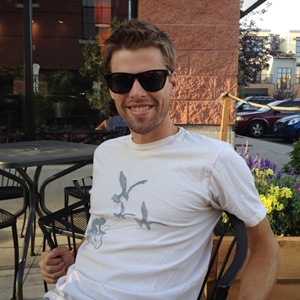
You may have heard of Mat Steinmetz before. Or, maybe you haven't. If the latter is the case, we'd like to introduce you. A former Retul employee, Mat has now struck out on his own to start a business of all things triathlon? What does he do? Coaching, bike fitting, cosulting, bloodwork analysis, wind tunnel consulting, carrying luggage, and just about anything that will make an athlete faster.
He has a few clients you may have heard of. A mid-pack pro named Craig "Crowie" Alexander, and a female named Mirinda "Rinny" Carfrae. These two world champions (and many other high-level athletes) have fully trusted Mat with their training program, equipment setup; essentially the total performance package. Despite these big names, Steinmetz has kept a relatively low profile over the years.
I've personally known Mat for several years. Introduced by a mutual friend, we've kept in touch and see each other at races throughout each year. I had the chance to catch up with Mat via telephone only a week out from Kona 2012, to hear about his new business, and his thoughts on his athletes' chances for success.
Slowtwitch.com: Tell us about how you got in to triathlon.
Mat Steinmetz: Sure. I grew up playing sports – it’s really all I ever cared about. Mostly ball sports, but I dabbled in triathlon and cycling when I was around 7 or 8. I didn’t mess around either. I had a Schwinn road bike, clipless pedals, cycling shoes, Lemond aerobars, and a disc wheel cover… I was into it! However, being from Indiana, basketball won out over prancing around the cornfields in Lycra.
After high school, I attended Ball State University, which has one of the best sports science programs in the US, not to mention one of the first Human Performance Labs. By the time I finished my Master’s degree in sports performance, I knew I wanted to work with endurance athletes at the highest level. To better my chances I moved to Boulder CO, since so many top athletes live there.
As for my progression in triathlon, I call it “Fast in Indiana”. In most sports growing up, I would be the best, or one of the best in my school or in the area. I always kind of had that standard set for myself… but didn’t really realize that it was somewhat due to the fact that we were in a small town. After college I got very attracted to Ironman and stepped in to it way too quickly. My first triathlon was a half Ironman… and then I did Ironman Arizona next. I was 25 years old, I hadn’t really done the sport, and I jumped right in there. I don’t think my body was ready and I just broke down. This was all during the time that I decided to move to Boulder. I could do training sessions with some of the pro athletes, so I kept holding on to that idea [of trying to go pro]. I told myself that “Oh, I’m young, I’m still on this upswing”. And I kept plugging away. I’d be good until about mile 12 or 13 of the run – I’d be one of the top age groupers, and I’d be clicking off seven minute miles… and then I’d fade away and DNF. I just had unrealistic expectations for where I was.

I started hanging around the best pro triathletes in the world – like Crowie. And I just saw the level they were at. I went to watch Kona in 2009, and I remember standing at the energy lab, and I saw Crowie come out. And it was just like, “Man… I have no desire to ever [race Kona]. These guys are amazing. I don’t want to suffer like that… I just don’t have it in me to do that.” I started coming to that realization. It’s almost like they’re my kids – even though they’re older than me. {laughs} I guess I’m living my athletic dreams through them. I can have a bigger impact on them than I could being an athlete myself. If I couldn’t be one of the best, I almost didn’t want to [race at all]. It’s a little odd – I know – but I love my job and it works well. They have the mental toughness that I never ever had.
ST: How did you get started with bike fitting?
Mat: In Boulder, I focused on putting myself in a position to learn from others – working my way into the right circles where I could soak up information. I paid attention to everything. I studied the sport, read, and listened to the experts. I began to develop my own ideas, but kept an open mind. I was never scared to change my opinion as I gain more knowledge or experience.
I had my first formal bike fit training in 2008 with Dan Empfield in Boulder. I still hadn’t considered doing bike fits for a living until I had the opportunity to work at Retul in 2009. From then on, I maintained a full commercial fit schedule, taught fit schools around the world, attended several pro cycling camps (Radioshack, Sky, Garmin, Trek-Leopard, and Geox) and fit a lot of the world’s top triathletes. I was able to gain a lot of experience in a pretty short time.
ST: You worked with Retul for quite a long time, but have recently become an entrepreneur. Please tell us about that.
Mat: I worked with Retul for several years. After I had been working with [professional] athletes for a while, they started coming in for more than just bike fits. They started asking about equipment setup, wind tunnel testing, training advice, which tire should I use, what chainring should I use for this race…? And I started developing a lot of relationships with athletes. While I was still with Retul, they allowed me to coach Crowie and Julie Dibens, and do a lot of this stuff on the side… so for a while it was the best of both worlds. And Retul was great – I got to travel around the world – but then I was never home, so it was tough, too. But as the company grew, they kind of needed me to pick one or the other. They needed everyone going one direction, and they weren’t willing to budge in letting me do this other stuff – which is totally understandable. They wanted me at my desk from nine to five.
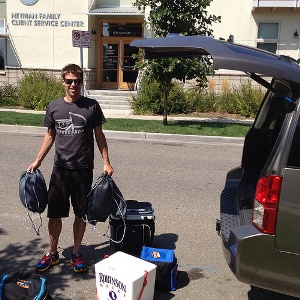
I felt like there was a big need in the professional triathlon ranks for someone like me. Most people think that all of the top tier pros have it easy – they get everything done for them, they get all this equipment and stuff. But in reality, there is a lot of support that they need. There’s not a lot of professionalism as far as what kind of assets these guys have available to them.
So I made the decision to leave Retul and start my own business, called 51 Speedshop. It’s basically everything I was doing before. I wanted to continue to do bike fits, to continue to go to the wind tunnel, I want to continue to coach… I want to continue doing all the things I like to do – and the things I think have a big impact on the athletes.
As for the name, I wanted something unique. I didn’t want it to be “Mat Steinmetz”, or “Craig’s coach”… I didn’t want to just be attached to someone’s name. And I didn’t want it to be “Something Endurance Coaching”… I wanted something cool, but didn’t really mean anything. I enlisted Tony DeBoom for help, who is a very creative guy. 51 is a lucky number in professional cycling. You’ll hear Phil Ligett and Paul Sherwin will say, “Oh – he’s got lucky number 51!” A lot of past Tour champions have been number 51. “Speedshop” is just wherever we set up shop for the day. It’s just kind of a virtual, mobile lab – I think of it like a hot-rod shop for triathlon. We’re looking to find free speed. Eventually I’d like the name to just stand on its own. I think of it like – create your own luck. You’re doing all the little details that will give you the best chance for success. 51 is lucky… with a little speed and a little luck, you’re going to be a faster athlete. I know that sounds kind of cheesy. {laughs}
ST: You talked about basic support for pros – and that they don’t always have a lot of it. Is that stuff as simple as having someone to build their bike up when they get to the race, or carry their luggage, or going to the grocery store for them? What kind of support do you think is necessary, and isn’t happening?
Mat: I don’t know if it’s necessary – if you’d say they’re entitled to it. I don’t know… do they need someone doing every little thing for them?
I think what it comes down to is that anything you can do to relieve some sort of stress on the athlete will impact performance. Trying to drag two pieces of luggage and your bike through the airport… sure, people have to do that… but you might pull a back muscle, or you might strain something. So that’s important, but it’s even more simple stuff, like knowing what wheel to ride, or how to glue a tire properly. It’s about having someone who can take care of this stuff. You know, I’m not a mechanic, but I have a great one that I work with. So we work together, and I let him know based on the latest research – what tires to use, or how I want them glued. Or we look at the bike and say, can we get rid of these cables sticking out here? Can we do X, Y, and Z to make the bike faster? A lot of the athletes are honestly so busy training that they’re not reading, they’re not doing the research. Sometimes they aren’t even taking advantage their sponsors that well. For example, some of the guys at Specialized are really knowledgeable, and can be super helpful. But they can’t be there with the athlete in-person day in and day out. That’s what I try to do, and help manage that interaction.
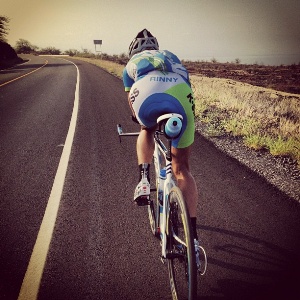
When the top triathletes are training at a very very high level… it’s really about all they’re good at. And I don’t mean that in a bad way. {laughs} They work so hard at training that some other stuff just falls by the wayside. So I may just be doing stuff like ordering the right parts for them, but it’s also getting the right helmets, shoes, [writing their training plans] – just a bunch of stuff.
ST: It almost sounds like they’re paying for your “brain time”. For you to think of stuff that they don’t have the capacity to deal with – and just figure it out, and basically prepare it for them. Does that sound right?
Mat: Yeah, that’s a good way to put it. It’s no secret that the athletes I’m working with are already at a very very high level. We’re really doing a lot of fine tuning, and just a lot of simple things – sports psychology, giving them confidence. For some reason – and I don’t intend this to sound arrogant – but I tend to connect really well with athletes, and they listen to me. I don’t think I’m a salesman, and I don’t know exactly what it is that allows me to do it, but it works. I really try to build trust over time with them. I know there’s so much on the line for them… that I don’t want to be wrong. I almost think about it like – “That’s my bike right there.” I don’t think of it like – well that’s Rinny’s bike, or that’s Crowie’s bike. If anything happens to it, it happens to me. I look at that bike as if it were my own.
ST: Who are your main clients?
Mat: For full-on coaching, Craig Alexander, Mirinda Carfrae, Julie Dibens, and Liz Blatchford. For consulting and bike fit, there are a lot. Just to name a few, Timothy O’Donnell, Linsey Corbin, Jesse Thomas, Leanda Cave, Cam Dye, Dirk Bockel. But I’ve fit a ton of people.
ST: Do you work with amateur athletes?
Mat: My primary focus to date has been with the professional athlete. With the launch of 51 Speedshop, over the next few months I'll be offering this experience to the AG athlete in some unique ways… I'm excited about it!
My overall aim for is to be a resource for coaches, athletes, and industry representatives to utilize. I can make an athlete faster without making them more fit and I think athletes of all abilities can benefit. So rather than being focused on just the training or just the [free] speed, I do both. Services include bike fit, wind tunnel testing, equipment and bike setup consulting, coaching, camps, mechanical services, and blood work analysis.
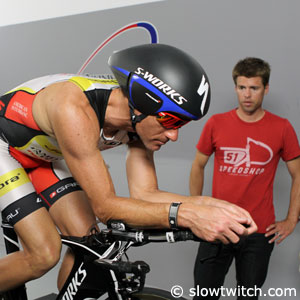
ST: Tell us about your relationship with Craig Alexander.
Mat: Craig was already doing very well for himself before I ever stepped foot in the picture. However, I’ve played a part over the past several years and have shared in Craig’s success. I started working with Craig in 2009 and he was the first person that really gave me a chance to work my sports science voodoo. {laughs}
My role with Craig is to be an honest sounding board, looking for all areas where he can find a gain or advantage. We’ve done quite a lot together: training program and analysis, bike position and setup, wind tunnel testing/aerodynamics, equipment selection and optimization, physiology testing, heat acclimation protocols, thermoregulation strategies, training and race support, race strategy, nutrition, blood work analysis. Basically, anything that relates to performance and/or Craig’s training, I serve a part in…even if it’s just making sure he has the right resources available to him in areas outside my expertise.
Craig knows that I won’t bullshit him and make something up just to seem smart and add my mark to the conversation. I take a lot of pride in the work I do and expect everything to be done at a very high level. There is a lot on the line and because of that; I’m not cavalier in my recommendations. I don’t want to be wrong! I do a ton of research and background work, staying current on the latest technologies and sports science research that can give us an edge. I like to make data driven decisions rather than taking someone’s word for it. If I don’t know something or have an answer to a question, I’m not shy to say “I don’t know”, but am proactive in using my resources to find the right answers. We’re not talking life or death here, but these decisions have an impact on Craig’s career.
ST: And what about your work with Mirinda Carfae?
Mat: I love Rinny – she’s old school. {laughs} I’m actually reading the Kona predictions on Slowtwitch right now. People are just like, “Rinny’s not going to win, she just switched back from the short cranks…” But people just don’t have all the information. What happened last year with Rinny… she came to me immediately after [Kona] and said, “Let’s get to work.” In the past she has been very resistant to change, she would just dip her toes in the water. But she was ready for it, and we drastically changed her bike position.
So we did all this stuff, but then she immediately shipped off to Australia for the winter. I didn’t like it, because I didn’t get to see [the changes] through. She had this new position, and the short cranks, and we had done some changes with her cadence. Everything was totally different, but I just didn’t get to see it through in-person. She raced Melbourne, and just simply had a bad race. She felt bad on the bike and the run – and she was happy about that… because she wouldn’t want to feel bad on the bike and then great on the run. She would have wondered what’s going on even more. So she just had this bad race… but the moment you get bad feedback on something, you start to question it. The big obvious change was the 155mm cranks, so it was the natural culprit. A 155 just doesn’t “sound” normal. You can wrap your head around a 165, but a 155 just doesn’t seem normal because it’s different. It wasn’t that the 155’s didn’t work, she just had a bad initial experience. We had to get on with the season, so it just made sense to revert back to what she was comfortable with. I think next year, you will see her back on short cranks. I mean – now she’s riding the same crank length as Julie Dibens.
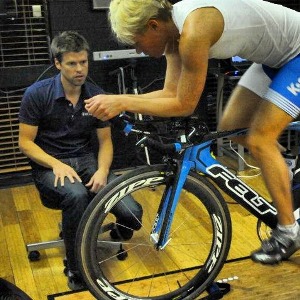
Rinny tended to ride with a low cadence and mash this huge gear. If you have that style and you throw a short crank on there, it’s going to feel different. So she switched back [to 165’s] a long time ago. She’s been on them most of the year. And it’s just been teaching her to posture herself on the bike. Posture isn’t the same as position. How to lay across the front end, how to drop your head, how to have nice hands on the front of the bars. How to pedal smooth. Raising her cadence has smoothed out her pedal stroke a lot. Moving her forward on the bike has helped – I call it “angle of attack” on the bike.
She’s riding great. She’s using a power meter now… and I’ve had to wrap my head around how low her watts are. But she’s so small. She’s sitting there going 40k an hour on 180 watts. If I’m with her, I might be at 250 [watts]. We’re having to work even on the psychology of that. At first, she’s thinking, “Gosh – I’m weak!” But if you look at watts per kilo, she’s right there with the best. I never really looked at speed, but we have to with her. I’m telling her – you’re going 38, 40 kilomoters an hour, on not a lot of power. She’s just small.
I think sometimes [the training effect] doesn’t happen right away. I think Rinny still has a long way to go, but I think she’s going to keep getting better every year. It’s not like I have this magic wand and all of a sudden she’s this “uber cyclist”. Even with someone like Crowie, what he had done the previous four or five years all came together last year. So I think with Rinny it will take a little time.
She’d get bogged down with cadence… we really had to teach her to use power over rollers. She’d hit the rollers and stand up, and her watts would go up to 400. With a power meter, I can show her that. All we have to do is switch a few gears. It feels easier, because her perception has always been that pedal torque equals power. But look at your power now [at higher RPM] – you’re twenty watts higher than you were.
ST: Did you really have to coach her on cadence?
Mat: I don’t try to force cadence on people. Cadence is not an input. I almost look at it on a bell curve. There’s a middle ground that’s about 80 to 95. Once you’re in that, I don’t really care. I kind of let the athletes find out in training what feels best. Rinny likes that feeling of torque [at low cadence]. I have athletes train various cadences… some big gear strength work, some over-cadence work… and then a lot in the “meat” of the 80-95 range. I don’t really try to force it. I just try to stay away from what’s strange or what’s a lot different than everyone else. There’s a lot of things I don’t try to fit in the norm with, but cadence isn’t one of them. Cadence should reflect your effort or race duration. As you step up in race duration, your cadence will probably drop a couple RPMs per distance. I was looking at Rinny, and was saying to her, “You’re riding a 3 minute effort, and you look like you’re riding an Ironman.”
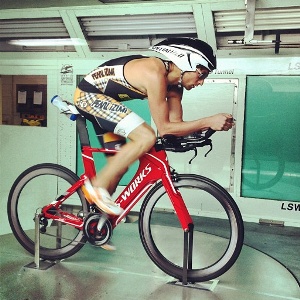
The whole theory used to be 72 cadence… 70 cadence – that’s magic. Everything you do should be at that cadence. No way. I looked at Rinny doing this 3 minute effort – I filmed her so she could see it. It was like “Look at you. It looks like you’re frickin’ riding the Race Across America. I want you to look like you’re riding a 3 minute effort.” And eventually we got it to where her cadence was revved up – and the power was a lot better.
ST: What is your philosophy on bike fit?
Mat: I don’t think I have much to say that’s not been heard before, but I’d like to reiterate a few things…
First off, the fitter is king. Fit tools, systems, protocols all help/aid the fitter, but are not substitutes for the eye of a good fitter. Advances in fit technology, when used properly, help to erase the human error involved in the measurement of the body and bike. A good fitter, to put it bluntly, knows what a good position looks like and has the skills to problem solve and guide a client towards that position. Good communication, listening to your client-making them part of the decision making process have been keys to my progression. I do think there is an art to fit and like most things, some are better at it than others.
Aerodynamics: The whole point of the TT position is to reduce aerodynamic drag.
Adaptability: The TT position is not a natural. You must train in the aero position if you ever expect your neck, shoulders, back, and crotch to be comfortable.
Saddle Comfort: I see the saddle as the biggest obstacle for an athlete in finding comfort in the aero position. I’m a fan of rider’s rotating forward on the saddle (anterior pelvic rotation). This takes the stress off the low back and hamstrings and allows the rider to posture properly onto the aerobars. This rotation places a lot of pressure on soft tissue areas and some riders can tolerate it while others cannot and NEED a saddle that eliminates this pressure.
Aerobar Contact: A rider needs to be supported on the front end of their bikes. This creates relaxation throughout the upper body. I don’t care for torqued wrists or armpads placed in the middle of the forearms.
Hip Angle: Short cranks and forward positions are all meant to preserve the hip angle. When people talk about getting too aero and not being able to produce power… it’s hip angle!
ST: What are your general thoughts on the late trending towards shorter cranks?
Mat: I’m a big fan of the shorter cranks and have influenced many of the world’s best athletes to try crank lengths that most folks would question (except the avid ST readers). I’ve never had an athlete go back to their original crank length after making the switch, except for a few pro cyclists. I think it will continue to gain in popularity as bike and component manufactures start making the move and stocking bikes with shorter cranks.

I think pro cyclist will eventually make the move, but you’re fighting a lot of tradition there. It will take getting one of the best time trialists in the world to have faith in it and to be successful. Another reason for the resistance is that they spend a lot of time on their road bikes, which will have longer crank arms. There is no question that most cyclists will be able to feel a difference when going to the shorter cranks on their TT bikes. A difference, even if it’s good, will worry them and the fact that they don’t ride their TT bikes often enough for that to go away. Triathletes will notice the difference but spend enough time on their bikes for the change to feel normal after a few weeks.
I still don’t know how short is too short. I will be interested in seeing where it goes from here.
ST: Even though you’re a relatively young guy in this industry, you seem to know a lot of history and a lot of people. What are the biggest differences between the “old school” world class athletes, and those who are performing at the top level today? Or are they really the same?
Mat: The level of competition from a pure numbers standpoint is better today. I do believe the athletes that were successful in the past would still be successful today…I don’t think that Mark Allen would be getting his ass handed to him if he were racing in his prime right now. Obviously, as the sport progresses, we get the chance to learn from those before us. The old school athletes were just trying to figure things out, they experimented and just trained hard.
I know people like to talk about how the times haven’t changed in Kona over the years, but I just think it’s because the style of racing has changed. For example, the men race like idiots in Kona. Here you have an 8+ hour event that is best raced at a steady state effort. However, listen to the men talk about attacks, closing gaps, doing work at the front, and riding in the group. It almost sounds like they’re in a bike race. These constant power spikes are not the best way to race an Ironman. Most of the athletes know this, but when you get a group of strong athletes together, humans make poor decisions. You either go with the flow or get left behind. I think the tale tell sign of this is in the run times. Except for a handful of athletes, the run times are very poor. The woman, who ride a more consistent TT have a lot more consistent run splits than the men.
I think what’s changing the quickest is woman’s racing. Chrissie took the sport to a new level, but the other woman followed and lifted their game.
ST: Do you have a website? How do new clients get in touch with you?
Mat: Yes, FiftyoneSpeedshop.com
The website will be updated with blog posts, news articles, videos, pictures, so you can check in and see all the cool stuff we’ve got going on.
And I’m on Twitter @MatSteinmetz


Start the discussion at slowtwitch.northend.network